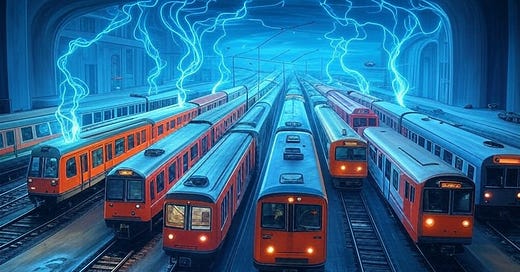Understanding the Context Window: A Train Station Analogy
How training data must be broken into sequences of tokens, adhering to the size of the context window. These sequences are then processed in batches, with batch size dependent on available hardware.
Imagine the world of Large Language Models (LLMs) as a bustling train station. In this metaphor, the neural network is the station itself, with its own fixed dimensions and operational rules. Let's dive into how this analogy helps explain one of the most critical aspects of LLMs: the context window.
The Context Window: Your Train Station
The context window in an LLM can be thought of as the length of the train station. Just as a train station has a limit on how long a train can be, each LLM has a cap on how many tokens (or pieces of text) it can process at once. Here are the context window sizes for some top LLMs:
Grok-1: 8,192 tokens
ChatGPT (GPT-3.5): 4,096 tokens
ChatGPT (GPT-4 standard): 8,192 tokens, with variants up to 128,000 tokens
DeepSeek-R1: 128,000 tokens
Claude (Anthropic): Up to 100,000 tokens
The context window is crucial because it dictates how much text the model can "see" at once, directly affecting its ability to understand context, make coherent responses, or generate text with continuity.
Preparing Training Data: Tokenization and Sequencing
When preparing data for training an LLM, think of your text as a long freight train. Here’s how you get it ready for the station:
1. Tokenization: First, you break down your text into tokens, which are like individual train cars. Each token could be a word, part of a word, or even punctuation, depending on the model's tokenizer.
2. Dividing into Sequences: Next, you need to cut this long train into smaller ones that fit within the station's length (context window).
Optimal Splits: The goal is to split at natural linguistic boundaries, like the end of sentences or paragraphs. This ensures that the semantic meaning remains intact, much like not breaking a sentence halfway through would keep the cargo's purpose clear.
Handling Long Texts: If a piece of text (train) is longer than the context window, you might split it, but with overlap if possible, to maintain some context. Imagine if you had to cut a very long train but wanted to ensure some continuity in the cargo.
Padding: If a sequence is shorter than the context window, you pad it with empty cars (padding tokens) to reach the station's length. This doesn't affect the training but ensures uniformity in processing.
The Role of Batches: Multiple Trains at Once
Now, imagine this station has multiple parallel rails where trains can enter simultaneously. This is where batching comes into play:
Batch Size: This represents how many trains (sequences) can enter the station at the same time. The number of rails and the station's width are analogous to how many GPUs and how much memory you have.
Real-World Batch Sizes:
Small Operations: With limited hardware, you might only have enough room for a few trains at once. A batch size of about 4 sequences is common in such scenarios, akin to a small, rural station.
Medium-Scale Applications: With more resources, you could handle batch sizes from 32 to 512 sequences. This is like a busy train station in a medium-sized city where multiple trains can be processed simultaneously for efficiency.
Large Commercial Applications: Here, we're talking about major hubs, where you might see batch sizes up to 4000 sequences or more, leveraging extensive hardware capabilities, like a vast, modern metropolitan station.
Drawbacks of Batch Sizes:
Too Small:
Inefficiency: Small batches mean more frequent parameter updates, which can slow down training due to the overhead of each update. However, they might lead to better generalization due to the stochastic nature of updates.
Computational Overhead: More iterations for the same amount of data, potentially leading to longer training times.
Too Large:
Memory Constraints: Larger batches require more memory, potentially leading to out-of-memory errors if not managed well.
Generalization Issues: They might converge faster per epoch but can lead to overfitting, as the model sees less variability in each update.
Optimization Challenges: The optimization landscape can become smoother but might miss out on finding good, sharp minima that generalize better.
Wrapping Up
Understanding the context window, tokenization, and batching through the lens of a train station analogy helps visualize how LLMs process and learn from text data. When preparing data for training, you're essentially ensuring each train fits perfectly into the station, maintaining the integrity of the cargo (text's meaning), and optimizing how many trains can be processed at once to balance efficiency with learning quality. Whether you're running a small operation or a large-scale commercial application, these considerations are pivotal in harnessing the full potential of LLMs.







